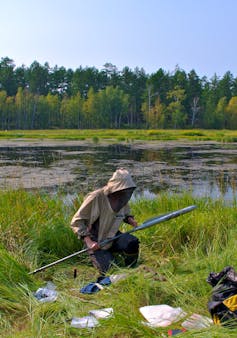
[ad_1]
Peatlands cover only a few percent of the world’s land area, but they store almost a quarter of all soil carbon and therefore play a crucial role in climate regulation. My colleagues and I have just produced the most accurate map to date of the world’s peatlands – their depth and the amount of greenhouse gases they have stored. We have found that global warming will soon mean that these peatlands will start to emit more carbon than they store.
Peatlands form in areas where water-saturated conditions slow down the decomposition of plant material and peat accumulates. This accumulation of carbon-rich plant remains has been particularly strong in the northern tundra and taiga regions where they have helped cool the global climate for more than 10,000 years. Today, large areas of frozen peatlands (permafrost) are melting, causing them to quickly release frozen carbon into the atmosphere in the form of carbon dioxide and methane.
Geoscientists have studied peatlands for a long time. They looked at why some areas had peat but others didn’t and they looked at how peatlands function as natural records through which we can reconstruct what the climate and vegetation looked like in the past (or even what was human life: many well-preserved ancient humans have been found in bogs).
[Read: Scientists are homing in on understanding just how sensitive our climate is to CO2]
Scientists have also long recognized that peatlands are important components of the global carbon and climate cycle. When plants grow, they take up CO₂ from the atmosphere and as this material accumulates in peat, there is less carbon in the atmosphere and therefore the climate will cool down in the long run.
Given all this knowledge about the importance of northern peatlands, it is perhaps surprising to learn that until recently there was no complete map of their depth and how much carbon there is. they store. That’s why I led an international group of researchers who developed such a map, which we can use to estimate how peatlands will respond to global warming. Our work is now published in the journal PNAS.

Peatlands are surprisingly difficult to map because their growth is linked to many local factors, such as how water flows across the landscape. That meant we had to collect over 7,000 field observations and use new machine learning-based statistical models to create the maps.
We found that peatlands cover approximately 3.7 million square kilometers. If it were a country, the “bog” would be slightly larger than India. These peatlands also store around 415 gigatonnes (billion tonnes) of carbon – as much as all the world’s forests and trees.

Nearly half of the carbon in northern peatlands is currently found in permafrost, year-round frozen ground. But, as the world heats up and the permafrost thaws, it causes peatlands to collapse and completely changes their relationship to greenhouse gases. Rather, areas that once cooled the atmosphere by storing carbon released more CO₂ and methane than they stored. We have found that the projected thaw from future global warming will result in greenhouse gas releases that will eclipse and reverse the carbon dioxide sink of all northern peatlands for several hundred years. The exact moment of this change is still very uncertain, but it is likely that it will occur in the second half of this century.
There are very extensive areas of permafrost bogs in western Siberia and around Hudson Bay in Canada. These unique environments and ecosystems will be fundamentally altered as the permafrost melts, and their characteristic mix of frozen peat mounds and small lakes will be replaced by vast areas of wet fens.
These changes will result in the release of more CO₂ and methane into the atmosphere as previously frozen peat becomes available to the microbes that degrade it. The thaw will also cause significant losses of peat to rivers and streams, influencing both food chains and the biochemistry of inland waters and the Arctic Ocean.
These new findings further heighten the urgency of rapidly reducing our emissions, because the only way to stop the thawing of permafrost is to limit global warming. No geoengineering solution can be deployed in these large and remote areas. Our results clearly show that a more limited global warming of 1.5 ℃ -2 ℃ would be much less damaging than our current trajectories of 3 ℃ -4 ℃ degrees or more.![]()
This article is republished from The Conversation by Gustaf Hugelius, Senior Lecturer, Physical Geography, Stockholm University under a Creative Commons license. Read the original article.
Read more:
Sleeping troubles? Netflix for sleep could be your answer to a better night’s sleep
Pssst, hey you!
Do you want to receive the most sassy daily tech newsletter, FREE, to your inbox? Of course you do: sign up for Big Spam here.
[ad_2]
Source link